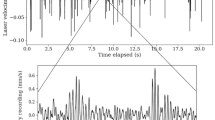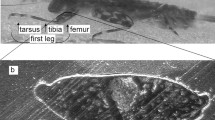Abstract
Coefficients of lift and drag for fifty lunulate sand dollars [Mellita quinquiesperforata (Leske 1778)], poised over a flat, sandy surface, were determined at seven different air stream velocities. Coefficients of static friction were obtained experimentally on level sand in standing water. Critical velocity, at which a sand dollar would be dislodged, is defined as that current velocity in which the force of drag is equal to the product of residual weight (i.e. weight-lift) and the coefficient of static friction. Small individuals have lower critical velocities than large ones: 26 cm s−1 and 43 cm s−1 for individuals 48 and 94 mm in diameter, respectively. Measurements were repeated for 20 of the controls, their lunules smoothly filled with modelling clay, and 20 from which lunule spines were removed. In every case, blocking the lunules decreased critical velocity, by an average of 15%; this was shown to be statistically significant (P>0.01). Removal of spines, which partially occlude the lunules, significantly (P>0.01) increased critical velocity by an average of 13%. Direct measurements in a water tunnel showed that calculated values of critical velocity were slightly too high, but otherwise confirmed the role of the lunules. Allometric analysis showed that as sand dollars increase in size, the distances of the lunules from the center of the disk increase less rapidly than the radii. A principal components' analysis of profile measurements of nine species indicated that lunulate and non-lunulate sand dollars are quite different in form. Lunulate species tend to be thinedged, flat-domed and larger in diameter. Some alternative ideas of lunule function are discussed and it is shown that there are no allometric or experimental data to support any of the suggested feeding hypotheses.
Similar content being viewed by others
Literature cited
Alexander, D. E. and J. Ghiold: The functional significance of the lunules in the sand dollar, Mellita quinquiesperforata. Biol. Bull. mar. biol. Lab., Woods Hole 159, 561–570 (1980)
Bell, B. M. and R. W. Frey: Observations on the ecology and feeding and burrowing mechanisms of Mellita quinquiesperforata (Leske). J. Paleontol. 43, 553–560 (1959)
Berrill, N. J. and J. Berrill. 1001 questions answered about the sea, 305 pp. New York: Dodd Mead and Co. 1957
Caston, V. N. D.: A wind driven near-bottom current in the North Sea. Estuar. coast. mar. Sci. 4, 23–32 (1976)
Clark, H. L.: Revision of the keyhole urchins (Mellita). Proc. U.S. nat. Mus. 89, (3099) 435–444 (1940)
de Ridder, C.: Feeding and some aspects of the gut structure in the spatangoid echinoid, Echinocardium cordatum (Pennant). Int. Echinoderms Conf., Tampa Bay. Remarks during question session. 1981
Fager, E. W.: A sand-bottom epifaunal community of invertebrates in shallow water. Limnol. Oceanogr. 13, 448–464 (1968)
Ghiold, J.: Spine morphology and its significance in feeding and burrowing in the sand dollar, Mellita quinquiesperforata (Echinodermata: Echinoidea). Bull. mar. Sci. 29, 481–490 (1979)
Goodbody, I.: The feeding mechanism of the sand dollar Mellita sexiesperforata (Leske). Biol. Bull. mar. biol. Lab., Woods Hole 119, 80–86 (1960)
Gould, S. J.: Allometry and size in ontogeny and phylogeny. Biol. Rev. 41, 587–640 (1966)
Gould, S. J.: Geometric similarity in allometric growth: a contribution to the problem of scaling in the evolution of size. Am. Nat. 105, 113–136 (1971)
Hyman, L. H.: Notes on the biology of the five-lunuled sand dollar. Biol. Bull. mar. biol. Lab., Woods Hole 114, 54–56 (1958)
Ikeda, H.: Functions of the lunules of Astriclypeus as observed in the righting movement (Echinoidea). Annot. Zool. Japon. 20, 79–83 (1941)
Kenk, R.: Ecological observations on two Puerto-Rican echinoderms, Mellita lata and Astropecten marginatus. Biol. Bull. mar. biol. Lab., Woods Hole 87, 177–187 (1944)
Lane, J. M.: Bioenergetics of the sand dollar, Mellita quinquiesperforata (Leske, 1778). Ph. D. dissertation, Department of Biology, University of South Florida 1977
Lane, J. M. and J. M. Lawrence: Food, feeding and absorption efficiencies of the sand dollar, Mellita quinquiesperforata (Leske). Esuar. coast. Shelf Sci. 14, 421–431 (1982)
Moss, J. E. and J. M. Lawrence: Changes in carbohydrate, lipid, and protein levels with age and season in the sand dollar Mellita quinquiesperforata (Leske). J. exp. mar. Biol. Ecol. 8, 225–239 (1972)
Murray, S. P.: Bottom currents near the coast during hurricane Camille. J. geophys. Res. 75, 4579–4582 (1970)
O'Neill, P.: Hydrodynamic analysis of feeding in sand dollars. Oecologia 34, 157–174 (1978)
Palmer, H. D. and D. G. Wilson: Nearshore current regimes in a linear shoal field, Middle Atlantic Bight, U.S.A. Congres Int. de Sedimentologie 9, 137–141 (1975)
Prandtl, T. F. and O. G. Tietjens: Applied hydro-and aeromechanics (1934), 311 pp. New York: Dover Publications Inc. 1957
Salsman, G. G. and W. H. Tolbert: Observations on the sand dollar Mellita quinquiesperforata Limnol. Oceanogr. 10, 152–155 (1965)
Seilacher, A.: Constructional morphology of sand dollars. Paleobiology 5, 191–221 (1979)
Smith, A. B.: The structure and arrangement of echinoid tubercles. Phil. Trans. R. Soc. Lond. B 289, 1–54 (1980)
Smith, A. B. and J. Ghiold: Roles for holes in sand dollars (Echinoidea): a review of lunule function and evolution. Paleobiology 8, 242–253 (1982)
Stanton, R. J., J. R. Dodd and R. R., Alexander: Eccentricity in the clypeasteroid echinoid Dendraster: environmental significance and application in Pliocene paleoecology. Lethaia 12, 75–87 (1979)
Telford, M.: A hydrodynamic interpretation of sand dollar morphology. Bull. mar. Sci. 31 605–622 (1981)
Telford, M. and A. S. Harold: Lift, drag and camber in the northern sand dollar, Echinarachnius parma Lamarck. Proc. Int. Echinoderms Conference, Tampa Bay, (1981) 1982
Telford, M. and R. Mooi: A peripheral ballast system for sand dollars. (In preparation)
Vogel, S.: Life in moving fluids, 352 pp. Boston: Willard Grant Press 1981
Warner, G. F.: Aggregation in Echinoderms. In: Symposium on the biology and systematics of colonial organisms (1976: Durham University). Ed. by G. Larwood and B. R. Rosen. 589 pp. London: Academic Press 1979
Author information
Authors and Affiliations
Additional information
Communicated by R. O. Fournier, Halifax
Rights and permissions
About this article
Cite this article
Telford, M. An experimental analysis of lunule function in the sand dollar Mellita quinquiesperforata . Mar. Biol. 76, 125–134 (1983). https://doi.org/10.1007/BF00392729
Accepted:
Issue Date:
DOI: https://doi.org/10.1007/BF00392729




